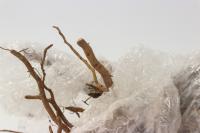1、 Curing method
1. Substrate selection: ramie has low requirements for soil, and basically can grow in any soil. However, the yield will be higher in deep, strong drainage capacity and fertile neutral soil. More soil should be prepared when configuring the soil. Bean dregs, rotten leaf soil, garden soil and an appropriate amount of small stones can be mixed to increase the permeability of the soil and ensure the basic nutrients needed for its growth

2. Temperature management: the best temperature for ramie growth is 16 ℃ to 30 ℃. If the temperature is lower than 7 ℃ in winter, the root will be frozen and need to be covered with soil or straw for winter. If the temperature is too high in summer, it will affect its flowering
3. Water management: Ramie growth needs a lot of water, which is suitable for growing in the soil with water content of 21% to 25%. The maximum soil water content cannot exceed 84%, otherwise it will affect the root respiration of ramie

4. Nutrient management: more nutrients are needed during the growth period. 24 kg of nitrogen fertilizer, 12 kg of phosphorus pentoxide and 16 kg of oxidized phosphorus can be applied per mu. Before overwintering, human and animal manure can be mixed with organic fertilizers such as rotten leaf soil and buried deep around ramie
2、 Breeding skills
1. Cutting: it is suitable for cutting in summer. Potassium permanganate liquid needs to be used to disinfect the soil before cutting. Pick the cuttings needed before the sun rises, and cut off the large leaves after the cuttings are collected. After being placed in a cool and ventilated place for about four hours, the cuttings were cut in about 3 cm of soil
2. Winter: the temperature needs to be kept at about 10 ℃ in winter. The method of covering soil can be used for insulation, covering the soil with a depth of about 8 cm to prevent freezing injury

3、 Diagnosis and treatment problems
1. Root rot: excessive watering or excessive ponding in the garden will lead to poor soil permeability, which will inhibit the respiration of the root and lead to root rot. Bordeaux liquid can be used for treatment
2. Longicorn beetle: when the quantity is small, it can be killed manually. The adults can be killed after shaking down from the branches, and the larvae can be killed with sharp tools or collected and burned in a centralized way. When the dosage is large, it can be treated with medicine. After mixing dichlorvos with water, it can be evenly sprayed on the plant surface, and the spraying times can be appropriately increased

4、 Other issues
1. Hydroponics: no hydroponics. Ramie has great requirements for soil permeability. Generally, excessive watering or ponding in the field will lead to ramie root rot. If cultured in water, it will completely inhibit the respiration of ramie roots, and in serious cases, it will lead to plant death
2. Whether it can be planted: it can be planted. Ramie is suitable to grow in deep and fertile soil. The amount of potted soil is small and the fertility is unstable, so it is suitable to plant in situ


 jackfruit
jackfruit snake plant
snake plant hibiscus
hibiscus hydrangea
hydrangea lavender
lavender Green roses climb al...
Green roses climb al... If you don't pay att...
If you don't pay att... Management of four g...
Management of four g...

































